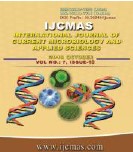


 National Academy of Agricultural Sciences (NAAS)
National Academy of Agricultural Sciences (NAAS)

|
PRINT ISSN : 2319-7692
Online ISSN : 2319-7706 Issues : 12 per year Publisher : Excellent Publishers Email : editorijcmas@gmail.com / submit@ijcmas.com Editor-in-chief: Dr.M.Prakash Index Copernicus ICV 2018: 95.39 NAAS RATING 2020: 5.38 |
Cucumber (Cucumis sativus L.) is belongs to family cucurbitaceae is one of the most popular and favorite vegetable crops in different parts of the world. The family has two subfamilies and includes 118 genera and 825 species (Judd et al., 2008). Most species are climbing perennial herbs. The family is important for edible fruits (Heywood et al., 2007; Judd et al., 2008). It is used either as fresh fruits or in pickling industry. Cucumber contains 0.4 per cent protein, 2.5 per cent carbohydrates, 1.5 mg iron, and 2 mg of vitamin C in 100 mg of fresh weight. Fruits are good for people suffering from constipation, jaundice and indigestion (Anonymous, 2014). Powdery mildew caused by Erysiphe cichoracearum (D.C.) is an important disease of cucurbits, particularly; cucumber is highly susceptible to this disease and suffers heavy losses in all localities of Maharashtra State, wherever it is grown. Cucumbers have been grown in India for more than 3000 years and around 2000 B.C. was brought to the area around the Mediterranean Sea and Egypt (Bjelland, 1988). Results of field efficacy of fungicides against powdery mildew indicated that disease incidence and disease intensity were declined only after second and third sprays. Disease incidence and per cent disease intensity after third treatment spray (85 DAS) was recorded in the range of 19.46 to 41.26 per cent and 27.30 to 74.66 per cent PDI, respectively as against unsprayed control. The fungicide hexaconazole (0.1%) showed significantly lowest disease incidence (19.46 %) and disease intensity (27.30 %) with maximum (61.85 %) mean per cent disease control. On the basis of effectiveness in controlling the powdery mildew disease of Cucumber, the most effective fungicides recorded in the order of merit were hexaconazole (0.1%), propiconazole (0.1%) and penconazole (0.1 %).
 |
 |
 |
 |
 |